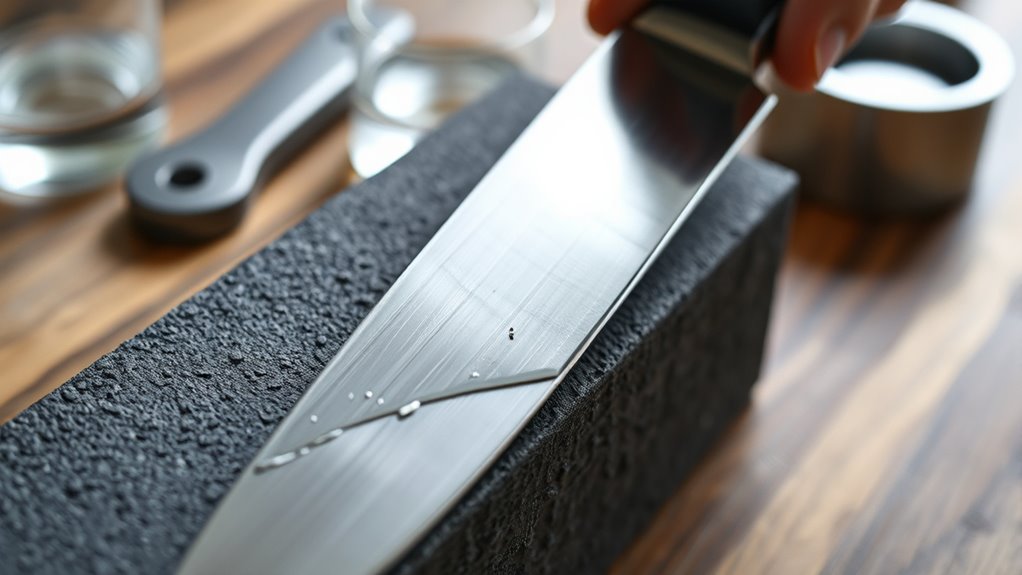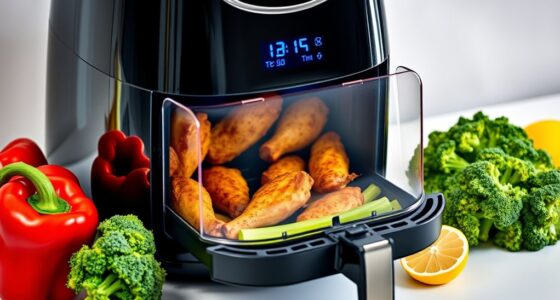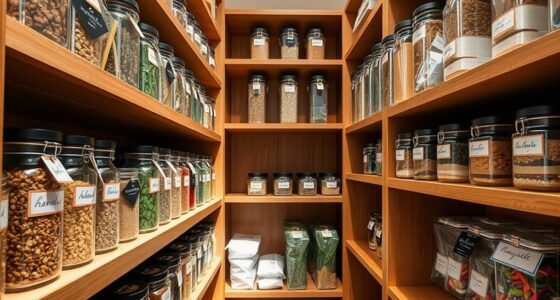To keep your knives sharp and safe, understand their types and needs, like ceramic or high-carbon blades, and choose proper tools such as sharpening stones or honing steel. Regularly check for dullness, rust, or handle damage, and use correct techniques to sharpen at the right angle with controlled strokes. Store your knives securely, and follow routine maintenance—like cleaning and inspection—to guarantee longevity. If you keep these basics in mind, you’ll maintain your knives effectively over time.
Key Takeaways
- Regularly inspect knives for dullness, nicks, rust, or handle damage; timely maintenance extends blade life.
- Use appropriate sharpening tools like whetstones or ceramic rods, maintaining consistent angles of 15-20 degrees.
- Hone the blade frequently with a honing steel to realign edges and prevent dullness.
- Clean and dry knives thoroughly after use to prevent rust and handle deterioration.
- Store knives securely in knife blocks or magnetic strips to maintain sharpness and ensure safety.
Understanding Your Knife Types and Their Needs

Have you ever wondered why different knives require different sharpening approaches? It all starts with understanding your knife types. Blade materials vary widely—from high-carbon steels to ceramic, each demanding specific sharpening techniques. High-carbon blades hold an edge longer but may rust if not cared for properly. Ceramic blades stay sharp longer but are more prone to chipping and require special tools. Additionally, handle ergonomics play a role in how you use and maintain your knife. A comfortable, well-designed handle ensures better control, reducing the risk of accidents and uneven wear. Recognizing these differences helps you choose the right sharpening method and tools, ensuring your knives stay sharp and safe to use. Knowing your knife type is the key to proper maintenance and longevity. Proper maintenance also involves understanding the importance of regular inspection, which helps identify early signs of wear or damage before they become serious issues.
Recognizing When Your Knife Needs Sharpening

Knowing your knife types helps you understand how they wear over time, but even the best blades need sharpening eventually. Signs include dullness that makes cutting effortful and uneven edges. You might notice increased blade corrosion, especially if moisture gets trapped or cleaning isn’t thorough, which weakens the metal. Handle deterioration, like loosened or cracked handles, can also signal the need for inspection, as compromised handles can affect control and safety. When your knife struggles to cut cleanly, or if you see visible nicks, dullness, or rust spots, it’s time to sharpen. Recognizing these signs early prevents further damage and extends your knife’s lifespan. Regularly check for corrosion and handle integrity to maintain highest performance. Additionally, understanding blade maintenance techniques can help prolong the sharpness and efficiency of your knives.
Essential Tools for Knife Maintenance
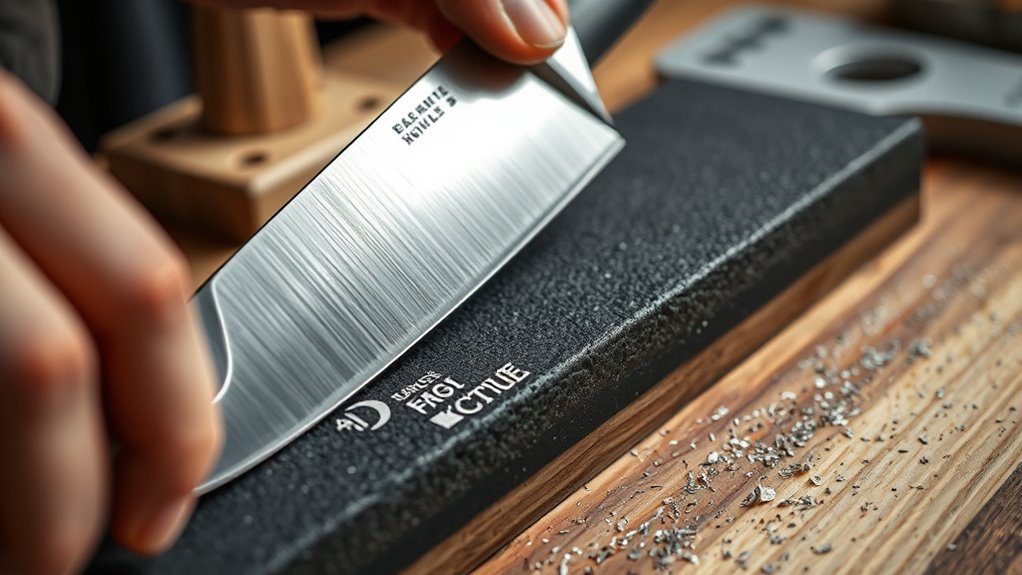
To keep your knives in top shape, you need the right tools. Choosing the proper sharpening stones and honing rods makes a big difference in maintenance. A well-stocked kit with essential items simplifies the process and guarantees your knives stay sharp and safe to use. For those interested in optimizing blade performance, understanding Mazda Tuning techniques can offer insights into maintaining equipment at peak condition.
Sharpening Stones Selection
Choosing the right sharpening stones is essential for maintaining a sharp and effective knife. You need to decide between ceramic vs. whetstone, considering how each type suits your needs. Ceramic stones are durable and produce a fine edge, but often require water or oil for lubrication. Whetstones, typically made of natural or synthetic abrasive material, come in varying grits and usually use water for lubrication. Here’s a quick comparison:
| Stone Type | Lubricant | Durability | Best For |
|---|---|---|---|
| Ceramic | Oil or water | Very durable | Fine tuning, polishing |
| Whetstone | Water | Moderate | Coarse to fine sharpening |
Your choice depends on your preference for oil vs. water and your sharpening skill level. Additionally, understanding the science behind sound vibrations can be useful for enhancing your sharpening technique by reducing vibrations and improving precision.
Honing Rods Usage
Honing rods are essential tools that help maintain your knife’s sharpness between sharpening sessions. Using a ceramic rod can be especially effective because ceramic rods are harder and gentler on blades compared to steel. When honing, hold the rod vertically or at a slight angle and draw the knife down the rod’s length, maintaining consistent pressure. Ceramic rods excel at realigning the edge without removing much material, making them ideal for routine maintenance. You might wonder about ceramic vs steel rods; ceramic rods are typically harder and produce less metal debris, which helps preserve your knife’s edge longer. Steel rods, while more durable, can sometimes straighten edges less effectively and may wear down over time. Choose a ceramic rod for gentle, precise honing to keep your knives sharp and ready. Regular use of honing rods can also contribute to maintaining your knife’s optimal edge quality over time.
Maintenance Kits Essentials
Having the right tools in a maintenance kit is essential for keeping your knives in peak condition. A well-rounded kit ensures you can perform knife cleaning, handle repair, and basic maintenance easily. Key tools include a sharpening stone, cleaning cloths, and a handle repair kit. The table below highlights essential items:
| Tool | Purpose | Frequency of Use |
|---|---|---|
| Sharpening stone | Restores blade edge | Regularly |
| Cleaning cloths | Remove dirt and debris | After use |
| Handle repair kit | Fix loose handles or cracks | When needed |
| Lubricant | Maintain moving parts | Periodically |
With these essentials, you’ll keep your knives sharp, clean, and functional for years to come. Proper maintenance tools can also incorporate AI-powered solutions to optimize upkeep routines.
The Proper Technique for Sharpening Knives

To sharpen your knives effectively, you need to master the proper technique that guarantees a consistent and safe edge. First, set the blade angle, typically between 15-20 degrees, depending on the knife and its steel hardness. Maintaining this angle throughout the sharpening process is essential for a sharp, durable edge. Use smooth, controlled strokes, applying consistent pressure as you slide the blade along the sharpening stone or steel. Start with the coarser side if sharpening from dull, then move to finer grit for polishing. Keep the blade angle steady, and ensure both sides are evenly sharpened. Proper technique minimizes metal removal and prevents damage, resulting in a sharper, longer-lasting edge that’s safe to use. Additionally, understanding knife sharpening techniques can help you achieve better results and prolong the life of your blades.
Honing vs. Sharpening: What’s the Difference?
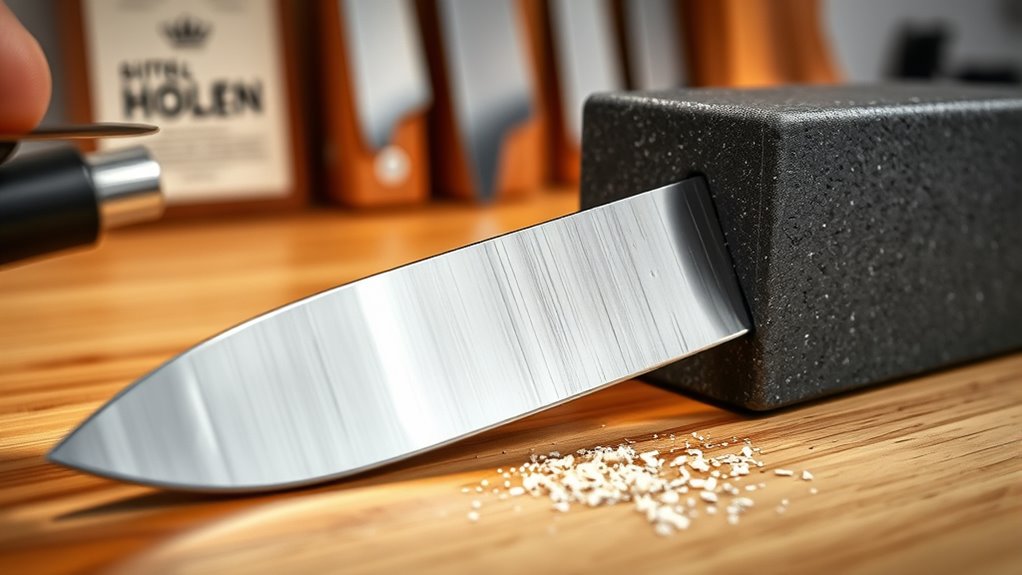
While sharpening removes metal to restore a dull edge, honing realigns the existing blade to maintain its sharpness. Sharpening reshapes the blade’s geometry, improving edge durability by removing nicks and rounding. Honing, however, uses a fine abrasive to straighten the microscopic teeth along the edge without removing significant material. Think of honing as maintenance for your blade’s precision, while sharpening is a deeper repair. Here’s a quick comparison:
| Aspect | Honing | Sharpening |
|---|---|---|
| Purpose | Realigns edge, maintains sharpness | Restores blade geometry, removes dullness |
| Material removal | Minimal | Significant |
| Frequency | Regular | As needed |
| Effect on edge | Preserves edge durability | Restores edge sharpness |
Understanding the difference helps you keep your knives performing at their best. Proper knife maintenance can extend the lifespan of your blades and ensure safety during use.
Safe Handling and Usage Tips for Knife Maintenance

To keep yourself safe while maintaining your knives, focus on proper grip techniques that give you control and reduce slips. Always use safe cutting practices, such as cutting away from your body and keeping your fingers clear of the blade. These habits help prevent accidents and make sure your knives stay in top condition.
Proper Grip Techniques
A proper grip is essential for safe and effective knife maintenance. Your knife grip influences control and safety during sharpening or cleaning. Keep your cutting hand firm but relaxed, with fingers curled inward to avoid slips. A secure grip prevents accidents and ensures precise work. Proper grip techniques also help maintain the blade’s edge and prolong its lifespan, especially when handling sensitive tasks like blade sharpening. Using the correct knife grip enhances stability and safety, especially when handling the blade during maintenance tasks. Always maintain a firm, controlled hold to prevent slips and accidents.
Safe Cutting Practices
Practicing safe cutting techniques is essential for preventing accidents and maintaining your knives in top condition. Always prioritize knife safety by keeping your fingers curled away from the blade and using a proper cutting technique. Use a stable cutting surface, and don’t rush through tasks. When slicing, apply even pressure and let the sharpness of your knife do the work. Keep your knives clean and dry to prevent slipping or rusting, which can compromise safety. Store knives securely, preferably in a knife block or on a magnetic strip, to avoid accidental cuts. Regularly inspect your knives for damage and sharpen them as needed to ensure clean cuts. Be aware that knife maintenance plays a crucial role in safety and efficiency. Adopting these safe handling practices will protect you and extend the life of your knives.
Storing Your Knives to Prevent Damage

Properly storing your knives is essential to prevent damage and maintain their sharpness. Using the right knife storage methods protects blades from dulling and chips. Consider storing your knives in a knife block, on a magnetic strip, or in protective sheaths. Protective sheaths keep blades covered when not in use, preventing accidental cuts and damage. Choosing the best option depends on your kitchen space and safety needs. Here’s a quick overview:
| Storage Method | Benefits |
|---|---|
| Knife block | Easy access, keeps blades organized |
| Magnetic strip | Saves space, quick retrieval |
| Protective sheaths | Protects blades, safe for drawer storage |
Always prioritize safe, organized knife storage to preserve sharpness and avoid accidents. Using diverse designs and materials such as ceramic or recycled products can also make your storage options more attractive and eco-friendly.
Regular Maintenance Routines for Longevity

To keep your knives sharp and in top condition, establishing regular maintenance routines is essential. Start by checking blade alignment; a properly aligned blade ensures even cutting and reduces unnecessary wear. Regularly inspect the edge and use a honing steel to realign the blade, maintaining sharpness between sharpenings. Pay attention to handle ergonomics as well—comfortable, secure handles reduce fatigue and improve control, preventing accidental damage. Clean your knives after each use with warm water and mild soap, avoiding harsh abrasives that can dull or damage the blade. Dry thoroughly to prevent corrosion. Incorporate these practices into your routine, and you’ll extend your knives’ lifespan while maintaining excellent performance. Consistent maintenance keeps your knives safe and efficient, saving you time and effort in the kitchen. Additionally, understanding how AI detection methods work can help you recognize content authenticity and ensure your maintenance tips are based on reliable information.
Troubleshooting Common Knife Care Issues

Even with regular maintenance, you may encounter common knife care issues that can affect performance and safety. Blade corrosion is a frequent problem, especially if your knife isn’t dried thoroughly after cleaning or stored in a damp environment. To prevent this, wipe the blade dry and store it in a dry place. Handle deterioration can also occur, such as loosened rivets or cracked handles, which compromise safety. Regularly inspect the handle for signs of wear and tighten or replace components as needed. If you notice corrosion or handle damage, address these issues promptly. Applying a protective oil can help prevent rust, and repairing or replacing damaged handles ensures safe, efficient use. Being aware of dog breeds and their specific care needs can also help you maintain your tools and equipment properly. Identifying and resolving these problems keeps your knife performing at its best.
Frequently Asked Questions
How Often Should I Sharpen My Knives for Optimal Performance?
You should sharpen your knives every 1 to 3 months for peak performance. Regular sharpening helps maintain the edge, which extends knife longevity and guarantees efficient cutting. Keep an eye on how your knives perform; if they start to drag or require more force, it’s time to sharpen. Consistent sharpening frequency keeps your knives in top shape and makes cooking safer and more enjoyable.
Can I Use Household Items to Sharpen My Knives Safely?
You can use household item alternatives for DIY sharpening, but proceed with caution. I once tried using a ceramic mug’s unglazed bottom, and it surprisingly restored my dull knife’s edge. Just remember, not all household items are safe or effective. Use a steel or ceramic rod if available, and avoid glass or abrasive materials that could damage your blade. Always prioritize safety and proper technique, even with simple DIY methods.
What Are the Signs of a Dull Knife Besides Difficulty Cutting?
You’ll notice your knife is dull if the blade shows discoloration or if you have to put in increased effort to cut. Discoloration can signal corrosion or wear, while increased effort means the edge isn’t slicing effectively anymore. You might also see ragged cuts or hear a dull thud instead of a clean slice. These signs indicate it’s time to sharpen or replace your knife for safe, efficient use.
How Do I Choose the Right Sharpening Stone Grit?
You choose the right sharpening stone grit by considering your knife’s condition and the type of edge you want. Start with a coarse grit (around 400) for dull or damaged blades, then progress to medium (800-1000) for general sharpening, and finish with fine (3000+) for polishing. Use abrasive materials with appropriate grit progression to achieve a sharp, smooth edge, ensuring each step refines the previous one for peak results.
Is It Necessary to Oil My Knives After Sharpening?
Yes, it’s important to oil your knives after sharpening. Studies show that proper maintenance can extend a blade’s life by up to 50%. Applying a light coat of knife oil, like mineral oil, helps prevent rust and corrosion as part of your maintenance routine. After sharpening, wipe your knife with oil to keep it in top condition, ensuring smooth cuts and longevity. This simple step makes a big difference.
Conclusion
By mastering these basics, you’ll keep your knives sharp and reliable, just like a trusty sword from a knight’s armory. Regular care and proper maintenance guarantee they serve you well through countless culinary adventures. Remember, even in an age of modern gadgets, a well-maintained knife remains your best tool in the kitchen. Stay diligent, and your blades will perform like a finely honed Excalibur, ready for whatever culinary challenge comes next.
